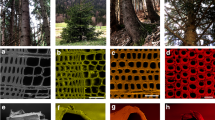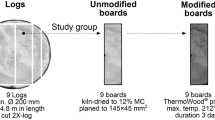Abstract
The fracture properties of Spanish Iceberg and English Round lettuce tissues were investigated using a tensile test on notched specimens. The level of notch sensitivity was investigated for samples of differing colour and vein orientation. Vein orientation perpendicular to the test direction proved to be the most notch sensitive and samples with vein orientation parallel to the test direction proved to be very notch insensitive, samples with a diagonal (45°) orientation showed an intermediate response. This response was interpreted in terms of the interaction of veins with the crack path. The strengths of English Round tissues were broadly comparable with those of Spanish Iceberg although the upper limits depended on vein orientation and were in the order: parallel > diagonal ≈ perpendicular. A similar ranking of vein orientation was found in estimates of stiffness.
Similar content being viewed by others
References
J. E. Holt and D. Schoorl, J. Text. Studies 14 (1983) 99.
A. G. Atkins and Y. W. Mai, “Elastic and Plastic Fracture; Metals, Polymers, Ceramics, Composites, Biological Materials” (Ellis Horwood, Chichester, 1985).
J. F. V. Vincent, J. Mater. Sci. 17 (1982) 856.
Idem., in “Advances in Botanical Research,” Vol. 17 edited by J. A. Callow (Academic Press, London, 1990) p. 235.
Idem., J. Mater. Sci. 26 (1991) 1947.
P. W. Lucas, M. F. Choong, H. T. W. Tan, I. M. Turner and A. J. Berrick, Phil. Trans. Roy. Soc. Lond. B 334 (1991) 95.
P. Purslow, in “Food Colloids,” edited by R. D. Bee, P. Richmond and J. Mingins (Royal Soc. Chem., London, 1989) p. 246.
F. ArtÉs and J. A. MartÍnez,Lebensm.-Wiss. u.-Technol. 29 (1996) 664.
H. Heimdal, B. F. KÑhn, L. Poll and L. M. Larson, J. Food Sci. 60 (1995) 1265.
A. A. Alsadon, Hortscience 28 (1993) 159.
H. Tada, P. Paris and G. Irwin, “The Stress Analysis of Cracks Handbook” (Del Research Corporation, St. Louis, Missouri, 1981).
P. Powell, “Engineering with Polymers” (Chapman and Hall, London, 1983).
S. Hiller and G. Jeronimidis, J. Mater. Sci. 31 (1996) 2779.
D. C. Phillips and B. Harris, in “Polymer Engineering Composites,” edited by M. O. W. Richardson (Applied Science, London, 1977) p. 45.
A. McGarry, Ann. Botany 75 (1995) 157.
K. W. Waldron, A. C. Smith, A. Ng, A. J. Parr and M. L. Parker, Trends Food Sci. Technol. 8 (1997) 213.
Author information
Authors and Affiliations
Rights and permissions
About this article
Cite this article
Toole, G.A., Parker, M.L., Smith, A.C. et al. Mechanical properties of lettuce. Journal of Materials Science 35, 3553–3559 (2000). https://doi.org/10.1023/A:1004809428967
Issue Date:
DOI: https://doi.org/10.1023/A:1004809428967




